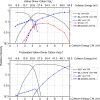Dissociation of Valine Cluster Cations
- PMID: 32931273
- PMCID: PMC7569673
- DOI: 10.1021/acs.jpca.0c07208
Dissociation of Valine Cluster Cations
Abstract
Independently of the preparation method, for cluster cations of aliphatic amino acids, the protonated form MnH+ is always the dominant species. This is a surprising fact considering that in the gas phase, they dissociate primarily by the loss of 45 Da, i.e., the loss of the carboxylic group. In the present study, we explore the dissociation dynamics of small valine cluster cations Mn+ and their protonated counterparts MnH+ via collision-induced dissociation experiments and ab initio calculations with the aim to elucidate the formation of MnH+-type cations from amino acid clusters. For the first time, we report the preparation of valine cluster cations Mn+ in laboratory conditions, using a technique of cluster ion assembly inside He droplets. We show that the Mn+ cations cooled down to He droplet temperature can dissociate to form both Mn-1H+ and [Mn-COOH]+ ions. With increasing internal energy, the Mn-1H+ formation channel becomes dominant. Mn-1H+ ions then fragment nearly exclusively by monomer loss, describing the high abundance of protonated clusters in the mass spectra of amino acid clusters.
Conflict of interest statement
The authors declare no competing financial interest.
Figures





References
-
- Yamashita M.; Fenn J. B. Electrospray Ion Source. Another Variation on the Free-Jet Theme. J. Phys. Chem. 1984, 88, 4451–4459. 10.1021/j150664a002. - DOI
-
- Fenn J. B.; Mann M.; Meng C. K.; Wong S. F.; Whitehouse C. M. Electrospray Ionization–Principles and Practice. Mass Spectrom. Rev. 1990, 9, 37–70. 10.1002/mas.1280090103. - DOI
-
- Rizzo T. R.; Stearns J. A.; Boyarkin O. V. Spectroscopic Studies of Cold, Gas-Phase Biomolecular Ions. Int. Rev. Phys. Chem. 2009, 28, 481–515. 10.1080/01442350903069931. - DOI
Grants and funding
LinkOut - more resources
Full Text Sources

